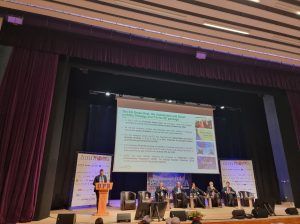 “The ‘Fit-for-55’ package of legislative proposals unveiled by the European Commission in July 2021 revises the EU’s entire climate and energy framework to lower greenhouse gas emissions by at least 55% by 2030, for which rail transport plays an important role to achieve the EU’s transport decarbonisation objectives,” Andrei Ciufu, the Head of Unit – Communications at UNIFE said during the Railway Days 2022 – Club Feroviar Investment Summit held in Bucharest on 22-24 March.
“The ‘Fit-for-55’ package of legislative proposals unveiled by the European Commission in July 2021 revises the EU’s entire climate and energy framework to lower greenhouse gas emissions by at least 55% by 2030, for which rail transport plays an important role to achieve the EU’s transport decarbonisation objectives,” Andrei Ciufu, the Head of Unit – Communications at UNIFE said during the Railway Days 2022 – Club Feroviar Investment Summit held in Bucharest on 22-24 March.
The event is organised by Club Feroviar and Politehnica University of Bucharest with the support of Romanian Railway Industry Association.
As the rail transport is one of the most sustainable mode of transport, accounting for only 0.4% of the greenhouse gas (GHG) emissions, it provides the prerequisite for a real shift from road transport to create a sustainable and resilient transport system across the EU.
Thus, the railway transport must be developed to become more attractive which is supported by the European Union through the investment and funding programmes. Under the Recovery & Resilience Facility EUR 55 billion will be invested in the rail transport with projects expected to be implemented by 2026. The Connecting Europe Facility, one of the most important funding tools for transport infrastructure, will provide EUR 18 billion for rail projects which represents 70% of the transport envelope supporting the creation of the Trans-European Transport Network (TEN-T), the digitalisation through the deployment of the ERTMS as well as the construction of the infrastructure for alternative fuels.
In addition, the Cohesion Fund is also sustaining the development of a greener, smarter and more connected Europe by providing EUR 300 billion which includes rail transport projects. Thus, the “Member States need to allocate significant funding in the Operational Programmes to achieve these objectives,” Andrei Ciufu highlighted.
The rail transport is 9 times less CO2 than the road transport and 7 times more energy-efficient compared to road transport as rail transport accounts 2% of the total EU energy consumption while carries 18% of the freight and 8% of passengers of all transport modes, according to the Community of European Railway and Infrastructure Companies (CER).
To increase the rail transport share, “improved green traction is a must, using hydrogen, other alternative fuels, as well as improved hybrid solutions using these sources of power. The rolling stock shall be made more affordable by new vehicle designs for light trains as well as become more attractive and easier to adapt with modular interiors,” Alberto Mazzola, the Executive Director of CER said at the Railway Days 2022.
This paves the way to a large-scale development and procurement of shunting locomotives, tram-trains, and locomotives with pure fuel cell or hybrid fuel cell on short and mid term, while long distance trains, mostly hybrid powered trains are expected in the long term, Mazzola explained.
This is the case for research and innovation activities which are carried out by the Europe’s Rail Joint Undertaking, the successor of the Shift2Rail JU, to support the development of a sustainable and green rail system. The initiative aims at delivering a high-capacity, flexible, multi-modal, resilient and integrated European railway network by eliminating barriers to interoperability and providing solutions for full integration, for European citizens and cargo.
Europe’s Rail research and innovation programme will meet the evolving customer requirements, will improve the performance and capacity while will reduce the costs. It will also deliver a hasmonised approach to evolution and greater adaptability, will reinforce the role for rail in European transport and mobility and will improve the EU rail supply industry competitiveness.
To achieve these objectives, the Europe’s Rail Joint Undertaking “has launched the first round of call for proposals which is open to all eligible entities in accordance with Horizon Europe. EU-Rail Call 2022 includes six projects which will benefit from a EUR 234 million EU contribution,” said Javier Ibáñez de Yrigoyen, Seconded National Expert – Programme Manager at Europe’s Rail JU.
A true modal shift towards railways will be supported by the TEN-T revision, the acceleration of ERTMS deployment which will improve the infrastructure and create additional capacity while ensuring the traffic management, and by a fair intermodal competition to reduce the emissions and develop a sustainable transport system across the EU which is highly supported by the Fit-for-55 policy.
Share on:







